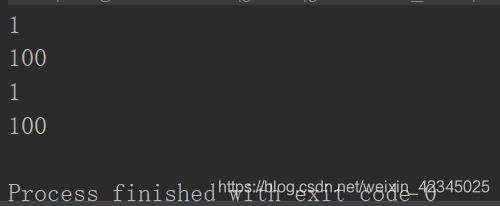异常处理:要将范围相对较小的异常放在前面、范围相对大的异常放在后面
try
{
int[] a=new int[5];
a[6]=0;
}
catch(ArrayIndexOutOfBoundsException ee)
{
System.out.println("发生了数组下标越界异常");
}
catch(Exception e)
{
System.out.println("其他exception occured:"+e);
}
finally
{
System.out.println("finally中的语句肯定执行");
}
运行结果: finally语句无论程序中是否发生异常都被执行
finally语句无论程序中是否发生异常都被执行
try...catch...finally语句:
一、当不存在catch时,finally必须存在且紧跟try(catch和finally两者可以有一个不存在);
二、try-catch-finally语句间不能存在任何语句(除注释)
throws/throw 关键字:
如果一个方法没有捕获到一个检查性异常,那么该方法必须使用 throws 关键字来声明。throws 关键字放在方法签名的尾部。
也可以使用 throw 关键字抛出一个异常,无论它是新实例化的还是刚捕获到的。
throws:声明这个方法会抛出这种类型的异常
throw:抛出一个异常:新实例化的/刚捕获到的
package com.test;
import java.io.IOException;
class HelloException extends Exception
{
public HelloException()
{
}
public HelloException(String s)
{
super(s);
}
}
public class exc {
public void withdraw()throws IOException, HelloException
{
System.out.println("hello");
throw new HelloException("发生了hello异常");
}
public static void main(String[] args)throws IOException
{
exc ex=new exc();
try
{
ex.withdraw();
}
catch (IOException m)
{
throw m;
}
catch(HelloException h)
{
System.out.println(h);
}
}
}
自定义异常:
package com.test;
class HelloException extends Exception
{
public HelloException()
{
}
public HelloException(String s)
{
super(s);
}
}
class deFen
{
public String name;
public int grade;
public deFen(){}
public deFen(String na,int gar)throws HelloException
{
this.name=na;
this.grade=gar;
if(gar>=0&&gar<=100) ;
else
throw new HelloException(name+"分数出错");
}
}
public class exc {
public static void main(String[] args)
{
deFen d1;
deFen d2;
try
{
d1=new deFen("jack",87);
d2=new deFen("cheater",102);
}
catch (HelloException he)
{
System.out.println("发生异常:"+he);
}
}
}
运行结果
tips:子类被重写(Override)方法不能比父类被重写方法声明(throws)更多的异常
内部类:
在外部类外访问内部类:要先创建外部类对象,然后以外部类对象为标识来创建内部类对象
package com.test;
class outer
{
class inner
{
int i=1;
int j=2;
}
}
public class innerClass
{
public static void main(String[] args)
{
outer.inner i1=new outer().new inner();
System.out.println("Method "+i1.i);
outer o1=new outer();
outer.inner i2=o1.new inner();
System.out.println("Method "+i2.j);
}
}

在内部类中访问外部类:是没有限制的
在内部类直接访问时(对于同名的成员变量),将访问的时内部类的成员变量;若想访问外部类,就要先创建一个外部类对象,然后使用该对象调用外部类成员变量。
使用this也可以指向当前对象的引用,完成内部类访问同名成员变量
package com.test;
class outer
{
int i=100;
class inner
{
int i=1;
outer o=new outer();
public void myVoid()
{
System.out.println(i); // 1
System.out.println(o.i); // 100
System.out.println(this.i); // 1
System.out.println(outer.this.i); // 100
}
}
}
public class innerClass
{
public static void main(String[] args)
{
outer.inner i1=new outer().new inner();
i1.myVoid();
}
}
运行结果:

局部内部类:
内部类作为局部成员出现:只能再它所在的方法中进行调用
class Wai
{
public void myVoid()
{
class Nei
{
int i=5;
}
Nei n=new Nei();
System.out.println(n.i);
}
}
在局部内部类中可以直接调用外部类成员变量;在局部类中不能访问普通的局部变量,必须将该局部变量声明为final
静态方法中的局部内部类:静态方法中的局部内部类可以访问静态成员变量
静态内部类:
在外部类中访问静态内部类:要先创建内部类对象,再调用内部类成员
在外部类外访问静态内部类:可以直接创建内部类对象
Wai.Nei wn=new Wai.Nei();
























 1447
1447

 被折叠的 条评论
为什么被折叠?
被折叠的 条评论
为什么被折叠?








